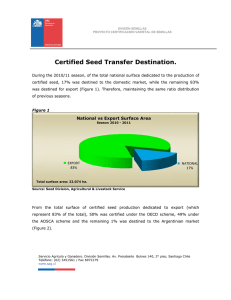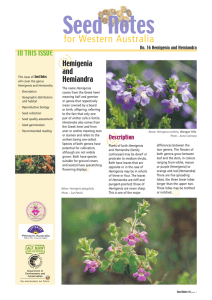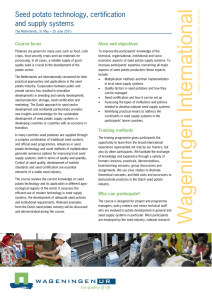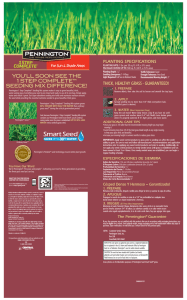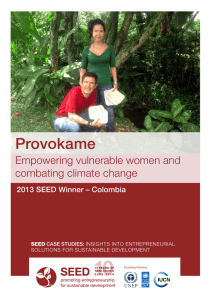Liquid compost factor: a biologically derived seed treatment for
Anuncio
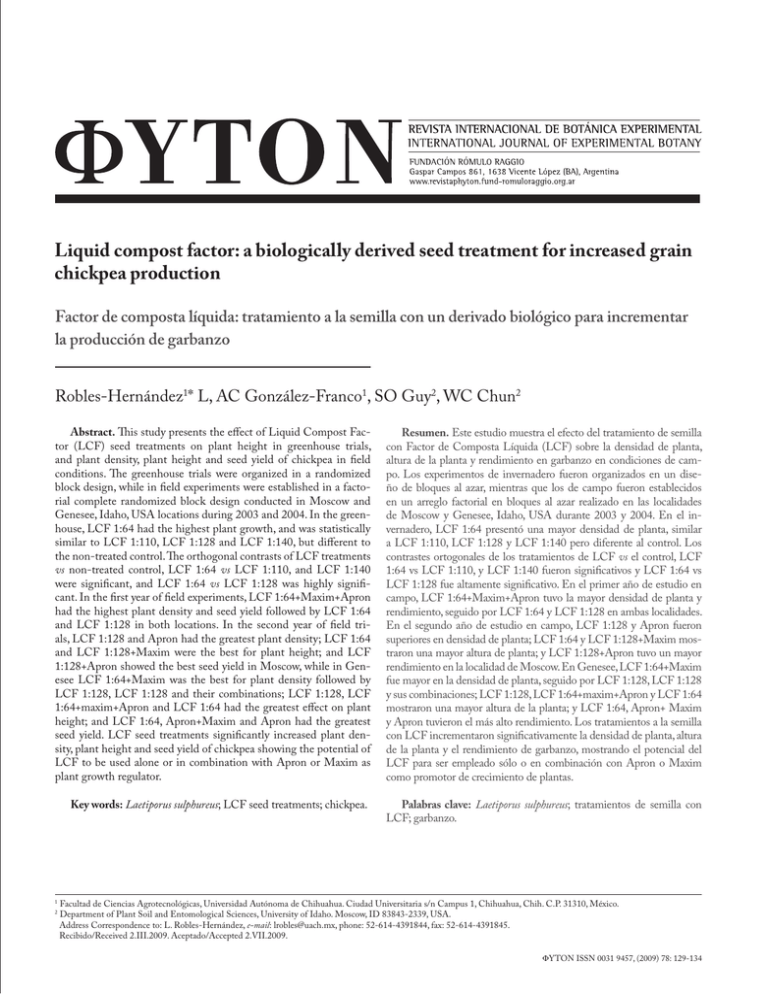
Liquid compost factor: a biologically derived seed treatment for increased grain chickpea production Factor de composta líquida: tratamiento a la semilla con un derivado biológico para incrementar la producción de garbanzo Robles-Hernández1* L, AC González-Franco1, SO Guy2, WC Chun2 Abstract. This study presents the effect of Liquid Compost Factor (LCF) seed treatments on plant height in greenhouse trials, and plant density, plant height and seed yield of chickpea in field conditions. The greenhouse trials were organized in a randomized block design, while in field experiments were established in a factorial complete randomized block design conducted in Moscow and Genesee, Idaho, USA locations during 2003 and 2004. In the greenhouse, LCF 1:64 had the highest plant growth, and was statistically similar to LCF 1:110, LCF 1:128 and LCF 1:140, but different to the non-treated control. The orthogonal contrasts of LCF treatments vs non-treated control, LCF 1:64 vs LCF 1:110, and LCF 1:140 were significant, and LCF 1:64 vs LCF 1:128 was highly significant. In the first year of field experiments, LCF 1:64+Maxim+Apron had the highest plant density and seed yield followed by LCF 1:64 and LCF 1:128 in both locations. In the second year of field trials, LCF 1:128 and Apron had the greatest plant density; LCF 1:64 and LCF 1:128+Maxim were the best for plant height; and LCF 1:128+Apron showed the best seed yield in Moscow, while in Genesee LCF 1:64+Maxim was the best for plant density followed by LCF 1:128, LCF 1:128 and their combinations; LCF 1:128, LCF 1:64+maxim+Apron and LCF 1:64 had the greatest effect on plant height; and LCF 1:64, Apron+Maxim and Apron had the greatest seed yield. LCF seed treatments significantly increased plant density, plant height and seed yield of chickpea showing the potential of LCF to be used alone or in combination with Apron or Maxim as plant growth regulator. Key words: Laetiporus sulphureus; LCF seed treatments; chickpea. 1 2 Resumen. Este estudio muestra el efecto del tratamiento de semilla con Factor de Composta Líquida (LCF) sobre la densidad de planta, altura de la planta y rendimiento en garbanzo en condiciones de campo. Los experimentos de invernadero fueron organizados en un diseño de bloques al azar, mientras que los de campo fueron establecidos en un arreglo factorial en bloques al azar realizado en las localidades de Moscow y Genesee, Idaho, USA durante 2003 y 2004. En el invernadero, LCF 1:64 presentó una mayor densidad de planta, similar a LCF 1:110, LCF 1:128 y LCF 1:140 pero diferente al control. Los contrastes ortogonales de los tratamientos de LCF vs el control, LCF 1:64 vs LCF 1:110, y LCF 1:140 fueron significativos y LCF 1:64 vs LCF 1:128 fue altamente significativo. En el primer año de estudio en campo, LCF 1:64+Maxim+Apron tuvo la mayor densidad de planta y rendimiento, seguido por LCF 1:64 y LCF 1:128 en ambas localidades. En el segundo año de estudio en campo, LCF 1:128 y Apron fueron superiores en densidad de planta; LCF 1:64 y LCF 1:128+Maxim mostraron una mayor altura de planta; y LCF 1:128+Apron tuvo un mayor rendimiento en la localidad de Moscow. En Genesee, LCF 1:64+Maxim fue mayor en la densidad de planta, seguido por LCF 1:128, LCF 1:128 y sus combinaciones; LCF 1:128, LCF 1:64+maxim+Apron y LCF 1:64 mostraron una mayor altura de la planta; y LCF 1:64, Apron+ Maxim y Apron tuvieron el más alto rendimiento. Los tratamientos a la semilla con LCF incrementaron significativamente la densidad de planta, altura de la planta y el rendimiento de garbanzo, mostrando el potencial del LCF para ser empleado sólo o en combinación con Apron o Maxim como promotor de crecimiento de plantas. Palabras clave: Laetiporus sulphureus; tratamientos de semilla con LCF; garbanzo. Facultad de Ciencias Agrotecnológicas, Universidad Autónoma de Chihuahua. Ciudad Universitaria s/n Campus 1, Chihuahua, Chih. C.P. 31310, México. Department of Plant Soil and Entomological Sciences, University of Idaho. Moscow, ID 83843-2339, USA. Address Correspondence to: L. Robles-Hernández, e-mail: [email protected], phone: 52-614-4391844, fax: 52-614-4391845. Recibido/Received 2.III.2009. Aceptado/Accepted 2.VII.2009. FYTON ISSN 0031 9457, (2009) 78: 129-134 130 INTRODUCTION Chickpea (Cicer aurientum) is an ancient legume that has been cultivated in India, Africa, the Middle East, the Mediterranean and Ethiopia for centuries (Oplinger et al., 1997; Berrada et al., 1999). Most of the United States chickpea production is concentrated in California and the Pacific Northwest (Corp et al., 2004). Chickpea is a drought tolerant, cool-season, legume crop. It performs best in silt loam or sandy soils with good drainage. Chickpea does not tolerate wet soils (Corp et al., 2004). Chickpea plants are upright with primary, secondary and tertiary branches. They flower abundantly and have an indeterminate growth habit. Pods set occur on all branches and the main stem, and they contain from one to two seeds (Stallknecht et al., 1999). Chickpea is classified into “desi” or “kabuli” types. Desi chickpea has small seed size (>100 seeds/ oz) and pigmented (tan to black) seed coat. Kabuli chickpea are cream-colored to white seed coats and can be small or large varying from >100 to <50 seeds/oz (Miller et al., 2002). Chickpea is a high value crop that is well suited for dryland cropping in the Pacific Northwest. Increasing germination frequency and stand establishment is thus very important under low rainfall conditions. Strong stand establishment may be important in alleviating disease pressure by soil-born pathogenic organisms. Problems of chickpea include poor seed germination due to seedling diseases, seedling rot, and damping off caused by Pythium spp., Fusarium solani, and Rhizoctonia solani. These pathogens infect seedlings soon after germination and weaken or kill them during seedling emergence, resulting in poor stands or reduced plant vigor (Miller et al., 2002). Studies in Genesee, Idaho have shown only a small percentage (10%) plant establishment and seed yield (30%) without seed treatment compared with standard fungicide seed treatments such as Captan, Maxim and Apron (Corp et al., 2004). Another alternative to improve seed germination and plant establishment is the new Liquid Compost Factor (LCF) product, which is a derived from pineapple, papaya, sugar cane products, and bioactive compounds of Laetiporus sulphureus. It is a type of compost tea fertilizer, soluble in water, intended to improve seed germination, root and foliage growth, flower bloom, and fruit yield when applied to soil under greenhouse conditions. Liquid Compost Factor is brown to dark in color and slightly denser than water. It has a mixture of gibberellins, auxins, cytokinins, absicic acid, and other unknown antimicrobial compounds that stimulate seed germination and growth of vegetables, ornamental flowers, fruit crops and growth inhibition of fungal pathogens. Two of these plant hormones, gibberellins and ABA are known to have opposite roles in seed dormancy. Gibberellins, produced by the seed embryo are important in breaking seed dormancy (Koornneef & Van Der Veen, 1980), whereas ABA is required for seed dormancy (Koornneef et al., 1982). The function of auxins and cytokinins in seed germination is less but they may play greater roles with growth and establishment FYTON ISSN 0031 9457, (2009) 78: 129-134 Robles-Hernández L et al., FYTON 78 (2009) of young seedlings. The antimicrobial compounds may suppress plant pathogens, and protect seeds and plantlets. Liquid Compost Factor has been tested as a growth supplement of several crops but it has never been used in temperate crops or crops under dryland cultivation. Thus, the objective of this study was to evaluate the effect of seed and foliar treatments of LCF on the performance of chickpea in greenhouse and field trials. MATERIALS AND METHODS Greenhouse trials. For greenhouse trials, LCF was diluted 1:45, 1:64, 1:80, 1:110, 1:128, and 1:140 with water, and used to treat chickpea seeds at a rate of 10 ml per 100 g seed. Ten seeds per pot were planted in Sunshine Mix No. 2 and incubated in a randomized complete block design with three replications. Plants were watered every other day and fertilized with a soil NP-K (14-16-16) fertilizer once a week. Average day/night temperatures were 32°C/28°C. Seedling emergence was counted ten days after planting, and plant heights were recorded every three days for up to 36 days. Root and shoot weights were recorded to determine plant biomass at the end of the experiment. Field trials. The field experiments were conducted at the University of Idaho research farms at Genesee and Moscow, Idaho, USA during 2003 and 2004. In both years, trials we used a factorial complete randomized block design. In the first year, ‘Dwelle’ kabuli-type chickpea seeds were treated with LCF diluted 1:64 and 1:128 with water at 640 ml/100 lb seed, Apron XL at 4.72 ml/100 lb of seed, and Maxim at 1.18 ml/100 lb of seed (100 lb=37.3 kg). Foliar applications of LCF at 1:500, 1:1000 and 1:5000 (LCF:water v:v) were applied at 20 gal/acre (187 l/ha) spray volume one month after planting, at 50% flower set, and just before pods set. In the second year, the LCF seed treatments included LCF 1:64, LCF 1:128, LCF 1:64+Maxim+Apron, LCF 1:128+Maxim+Apron, Apron+Maxim, LCF 1:64+Apron, LCF 1:128+Apron, LCF 1:64+Maxim, and LCF 1:128+Maxim. Concentrations of Maxim and Apron were 1.18 ml/100 lb seed and 4.72 ml/100 lb seed, respectively (100 lb=37.3 kg). In this year, foliar applications of LCF were made at rates of 100 ml/acre, 250 ml/acre, 500 ml/acre, and 750 ml/acre (1 acre=4047 m2) on chickpea plants treated with 3 gal/acre (11.3 l/4047 m2) of Uran (Nitrogen fertilizer solution, which contains 3.54 lbs N per gallon (1.61 kg N/3.785 l) as ammonium nitrate and urea mixed with sulfuric acid) or without Uran at 20 gal/acre (187 l/ha) total spray volume. All field plots were 20 feet (6 m) long by 5 feet (1.5 m) wide with seven rows seven inches (17.8 cm) apart. The planting depth was from 1½ to 2 inches (3.8 to 5.1 cm). At 21 days after planting, emerged seedlings were recorded to estimate plant density. Foliar applications of LCF or Uran were performed using a sprayer of 3-gallon (11.4 l) capacity equipped with a CO2-high-pressure tank. Sites were hand weeded. Plant heights were measured from soil surface to the average growth point in the canopy three weeks before harvest in the first year LCF seed treatment to increase chickpea production RESULTS Greenhouse trials. Seed treatments of LCF were performed to evaluate their effect on seed germination, plant height and plant biomass of chickpea. LCF seed treatments showed significant effect on plant height of chickpea but not on seed germination or plant biomass. Almost all LCF treatments on chickpeas were greater in plant height than the non-treated control. LCF 1:64 had the highest plant growth, and was statistically similar to LCF 1:110, LCF 1:128 and LCF 1:140 but different to the non-treated control. In shoot biomass the highest results were observed in the LCF 1:110 treatment, whereas in root biomass LCF 1:128 and LCF 1:45 presented the highest results compared with the non-treated control (Fig. 1). Plant height of chickpea was further analyzed using regression analysis and the resulting slopes were compared using orthogonal contrasts to determine the best treatments. Table 1 shows the results of the slope orthogonal contrasts. There were observed significant differences in chickpea between the comparisons of all seed treatments of LCF vs. the non-treated control, LCF 1:64 vs. LCF 1:110 and LCF 1:140. Highly significant differences were observed when LCF 1:64 and LCF 1:128 were compared. Figure 2 shows the results of plant height of the predicted lines, in which LCF 1:64, LCF 1:110, LCF 1:128 and LCF 1:140 were significantly higher than the non-treated control. The highest plant height was observed in LCF 1:64, which is in agreement with the results of the orthogonal contrasts. Fig 1. Effect of seed treatment application of LCF on chickpea plant height under greenhouse conditions. Bars with the same letter are not significantly different according to LSD test at p<0.05. 30 Plant height (cm) 30 25 28 28 28 a a a LCF 1:128 35 LCF 1:110 Fig 1. Efecto del tratamiento a la semilla con LCF sobre la altura de la planta bajo condiciones de invernadero. Barras con la misma letra no son significativamente diferentes de acuerdo con las pruebas de LSD a p<0,05. 24 23 20 20 b a LCF 1:64 b LCF 1:45 15 10 ab 5 LCF 1:140 LCF 1:80 CONTROL 0 LCF seed treatments Table 1. Effect of seed treatment application with LCF on chickpea plant height in the greenhouse. Orthogonal contrasts of slopes of plant height. Tabla 1. Efecto del tratamiento a la semilla con LCF sobre altura de la planta de Cicer aurientum en invernadero. Contrastes ortogonales de las pendientes de altura de planta. Treatment contrast LCF 1:64, LCF 1:110, LCF 1:128 & LCF 1:140 vs. non-treated control LCF 1:64 vs. LCF 1:110 & LCF 1:140 LCF 1:64 vs. LCF 1:128 Level of significance 0.0270 * z 0.0476 * <0.0001 *** Numbers followed by one star (*) are significantly different, and followed by three stars (***) are highly significantly different. z Fig 2. Effect of LCF seed treatments on the slopes of chickpea plant height in the greenhouse experiments. Fig 2. Efecto del tratamiento a la semilla con LCF sobre las pendientes de altura de planta de garbanzo en experimentos de invernadero. Non-treated control LCF 1:45 30 LCF 1:64 25 Plant height (cm) and in the second year, plant heights were recorded every two weeks, starting three weeks after germination and ending three weeks before harvest. After plants were established, plots were cut back to approximately 16 feet (0.48 m) by roto-tilling or application of Roundup using a tractor-mounted, shielded spray. Lengths were measured on all plots to accurately calculate the seed yield. All trials were maintained under grower equivalent management conditions. Seed yield and test weights were recorded at harvest. Planting and harvesting practices were performed according to the growth season of chickpea in the Pacific Northwest (Corp et al., 2004). Statistical analysis. For the field trials, the data was analyzed by analysis of variance (ANOVA), mean comparisons by LSD, and correlation analysis. All results reported are the average of four or six replications. For the greenhouse trials, ANOVA, mean comparisons by LSD, and for the portion of growth of interest, a linear model of the following formula was used: Yij = βoi + β1i + Dayij + eij where Yij is the plant height for the ith plant in the jth treatment, βoi is an intercept, β1i is the slope for or rate of growth and eij is an error term. Slopes were analyzed using orthogonal contrasts to determine the best LCF seed treatment performer on plant height. The package used for the analyses was SAS 8.2© 1999-2001 by SAS Institute Inc., Cary, N.C., USA. 131 LCF: 1:80 20 LCF: 1:110 LCF: 1:128 15 LCF: 1:140 10 5 0 0 3 6 9 12 15 18 21 24 27 30 33 36 Days after germination FYTON ISSN 0031 9457, (2009) 78: 129-134 132 Robles-Hernández L et al., FYTON 78 (2009) Field trials. In the field trials conducted in 2003, all seed treatments significantly increased plant density and seed yield as compared with the non-treated control in both Moscow and Genesee locations (Tables 2 and 3). No significant effect on plant height or seed weight was observed by any of the LCF seed treatments. The foliar application timing or foliar application rates did not show significant effects on any of the parameters evaluated (data not shown). The highest plant density and seed yield was observed in LCF 1:64+Maxim+Apron followed by the LCF 1:128 and LCF 1:64. In all the cases, the non-treated controls presented the lowest yields and plant heights. The greatest correlations were detected in the variables seed yield and plant density and seed yield and seed weight (0.34, and 0.51, respectively) (Data not shown). Table 2. Effect of seed treatment with LCF on chickpea plant density, plant height, seed yield and test weight in 2003 Moscow, ID field trials. Tabla 2. Efecto del tratamiento a la semilla con LCF sobre densidad de planta, altura de planta, rendimiento y prueba de peso de garbanzo en experimentos de campo, Moscow, ID, 2003. Seed Treatments Non-treated Plant density (No. plants / m2) Plant height (cm) Seed yield (kg/ha) 100-seed weight (g) 29 c 55 a 1790 c 48 a LCF 1:64 44 b 56 a 2036 b 47 a LCF 1:128 45 b 55 a 2050 b 47 a LCF 1:64 + Maxim + Apron 55 a 57 a 2167 a 48 a z Mean values within each column followed by the same letter are not significantly different according to LSD test at p<0.05. z Valores promedio dentro de cada columna seguidos por la misma letra no son significativamente diferentes de acuerdo con las pruebas de LSD a p<0,05. z Table 3. Effect of seed treatment with LCF on chickpea plant density, plant height, seed yield and test weight in 2003 Genesee, ID field trials. Tabla 3. Efecto del tratamiento a la semilla con LCF sobre la densidad de panta, altura de planta, rendimiento y prueba de peso de garbanzo en experimentos de campo, Genesee, ID, 2003. Seed Treatments Non-treated Plant density (No. plants / m2) Plant height (cm) Seed yield (kg/ha) 100-seed weight (g) 24 c 59 a 1957 c 46 a LCF 1:64 41 c 59 a 2315 ab 46 a LCF1: 128 43 b 58 a 2266 b 46 a LCF 1:64 + Maxim + Apron 53 a 59 a 2417 a 46 a z Mean values within each column followed by the same letter are not significantly different according to LSD test at p<0.05. z Valores promedio dentro de cada columna seguidos por la misma letra no son significativamente diferentes de acuerdo con las pruebas de LSD a p<0,05. z FYTON ISSN 0031 9457, (2009) 78: 129-134 In 2004 field trials, almost all LCF seed treatments significantly increased plant density, plant height, and seed yield in the two locations (Tables 4 and 5). However, the results were slightly different in the two locations. In Moscow, LCF 1:128 and Apron presented the highest plant density, while in Genesee, the highest plant density was observed in LCF 1:64+Maxim. The non-treated control had the lowest plant density in the Genesee location. The highest plant height was observed in LCF 1:128+Maxim and LCF 1:64 in both locations. LCF 1:128+Apron had the highest seed yield in Moscow, while in Genesee, the highest yield was observed with Maxim, who is statistically similar to LCF 1:64+Apron and Apron+Maxim. The non-treated control had the lowest seed yield in Genesee (Table 4 and 5). None of the foliar treatments of LCF or Uran showed significant effects on any of the variables evaluated (data not shown). Table 4. Effect of seed treatment with LCF on chickpea plant density, plant height, seed yield and test weight in 2004 Moscow, ID field trials. Tabla 4. Efecto del tratamiento a la semilla con LCF sobre la densidad de planta, altura de planta y prueba de peso de garbanzo en experimentos de campo, Moscow, ID, 2004. Seed Treatments Non-treated Plant density (No. plants / m2) Plant height (cm) 100-seed weight (g) Seed yield (kg/ha) 97 ab 37 ab 57 a 1251 ab LCF 1:64 99 ab 40 a 57 a 1277 ab LCF 1:128 109 a 38 ab 56 a 1251 ab LCF 1:64 + Maxim + Apron 86 ab 38 ab 56 a 1165 b LCF 1:128 + Maxim + Apron 75 b 35 ab 55 a 1146 b Apron 111 a 36 ab 56 a 1172 b Maxim 87 ab 38 ab 55 a 1265 ab Apron + Maxim 88 ab 38 ab 56 a 1132 b LCF 1:64 + Apron 97 ab 36 ab 56 a 1326 ab LCF 1:128 + Apron 84 ab 37 ab 56 a 1391 a LCF 1:64 + Maxim 95 ab 37 ab 56 a 1275 ab LCF 1:128 + Maxim 85 ab 40 a 57 a 1307 ab z Means within each column followed by the same letter are not significantly different according to LSD test at p<0.05. z Valores promedio dentro de cada columna seguidos por la misma letra no son significativamente diferentes de acuerdo con las pruebas de LSD a p<0,05. z DISCUSSION To study the effect of LCF on seed germination, plant establishment of dryland chickpea, LCF seed and foliar treatments were conducted during two consecutive years of field experiments in two different locations. The effect of LCF seed LCF seed treatment to increase chickpea production 133 Table 5. Effect of seed treatment with LCF on chickpea plant density, plant height, seed yield and test weight in 2004 Genesee, ID field trials. Tabla 5. Efecto del tratamiento a la semilla con LCF sobre la densidad de planta, altura de la planta y prueba de peso en garbanzo en experimentos de campo, Genesee, ID, 2004. Seed Treatments Non-treated Plant density (No. plants / m2) Plant height (cm) 100-seed weight (g) Seed yield (kg/ha) 49 b 36 ab 53 a 975 d LCF 1:64 86 a 38 a 54 a 1489 ab LCF 1:128 91 a 37 ab 53 a 1340 c LCF 1:64 + Maxim + Apron 80 ab 38 a 53 a 1370 bc LCF 1:128 + Maxim + Apron 82 a 35 ab 53 a 1469 ab Apron 86 a 36 ab 53 a 1430 abc Maxim 96 a 37 ab 53 a 1525 a Apron + Maxim 78 ab 38 a 54 a 1501 a LCF 1:64 + Apron 98 a 36 ab 54 a 1500 a 94 a 37 ab 54 a 1417 abc 108 a 36 ab 54 a 1416 abc 39 a 54 a 1468 ab LCF 1:128 + Apron LCF 1:64 + Maxim LCF 1:128 + Maxim z 85 a Means within each column followed by the same letter are not significantly different according to LSD test at p<0.05. z Valores promedio dentro de cada columna seguidos por la misma letra no son significativamente diferentes de acuerdo con las pruebas de LSD a p<0,05. z treatments on plant density, plant height and seed yield was demonstrated. During the first year, it was observed a significant increase on plant density and seed yield with LCF seed treatments as compared to the non-treated control. There was no difference on plant density or seed yield between LCF 1:64 and LCF 1:128 dilutions and complementary effects on these two variables were observed in the combination of LCF 1:64 or LCF 1:128 with Apron, Maxim or Apron and maxim together. It is clear that LCF treatments alone improve plant density and seed yield in the field. This could be attributed to its plant hormone content. During seed germination, gibberellins play a significant role in breaking seed dormancy (Koornneef & Van Der Veen, 1980; Debeaujon & Koorneef, 2000) and stimulating the production of enzymes required for mobilization of seed reserves (Lorenzo et al., 2002). They also play an important role in stimulating flowering and fruit set (Ozga et al., 2002; Tyler et al., 2004). Thus, LCF seed treatments might increase exogenous gibberellin content in the seed and speed up seed germination. Also the antimicrobial compounds of LCF may protect seed during germination and plantlets during establishment from attack of soil born plant pathogens. Rapid seed germination and plant protection by LCF could be beneficial to escape soil borne patho- gens responsible for seedling diseases, such as seedling rot, and damping off caused by Pythium spp., Fusarium solani, and Rhizoctonia solani (Miller et al., 2002). Substantial increase in plant density and seed yield were also observed when LCF 1:64 or LCF 1:128 were combined with Apron and Maxim. This indicates that there is a possible complementary effect between these two commercial fungicides and LCF and that they could be applied together to increase seed germination preventing seedling diseases. In addition to its plant growth promoting effect, in preliminary studies LCF inhibited growth of Pythium, Rhizoctonia and Fusarium in-vitro (data not shown). Apron is an inhibitor of nucleic acid metabolism and protein synthesis. Maxim has two active ingredients, including fludioxonyl and mancozeb. The target site of fludioxonyl in on MAP protein kinase in osmotic signal transduction and mancozeb has a multi-site activity. Both Apron and Maxim are seed protectant fungicides used to suppress fungal diseases caused by Fusarium sp., Rhizoctonia solani, and Pythium sp. (Syngenta catalog, 2001). In this study Apron and Maxim were used as positive controls and also to determine their synergism or antagonism with LCF. During the second year field study, the effects of LCF seed treatments varied within locations (Tables 4 and 5). The highest plant density was observed for Apron and LCF 1:128 seed treatments at Moscow and in LCF 1:64 + Maxim at Genesee. LCF 1:128 had the greatest yield at Moscow location; LCF 1:64, Apron +Maxim, and Maxim determined the best yield at Genesee. These results indicate, once again, the influence of LCF in increasing plant density, plant height and seed yield of chickpea as well as the complementary effect between LCF and Maxim or Apron in improving plant density and seed yield. LCF 1:64 and LCF 1:128+Maxim showed increases in plant height in both locations. However, since the components of Maxim are only fungicidal, the increase in plant growth must be attributed to the LCF plant hormones, specifically, gibberellins and auxins required for stem elongation. These results are consistent with those observed in the greenhouse trials, where LCF 1:64 also had the highest effect in plant height of chickpeas. Differences of LCF seed treatments on plant density and seed yield in the two locations in 2004 could be attributed to the soil conditions. At the Genesee location, the experiments were established in a sandier and well-drained soil, while in the Moscow location higher clay, more compacted, poorer drained soil was used. During the growth season, low rain caused soil to compact at the Moscow location and plants turned yellow with poor development, while at the Genesee location, plants remained healthier and more vigorous. Inspections for Ascochyta blight were performed but no disease was detected. Thus, the poor plant development in the Moscow location may be attributed to the soil conditions because chickpea performs best in silt loam or sandy soils with good drainage (Corp et al., 2004). In addition to plant growth promotion, LCF may play a significant role in the suppression of soil born plant pathoFYTON ISSN 0031 9457, (2009) 78: 129-134 134 gens. LCF inhibited species of Pythium, Fusarium and Rhizoctonia in-vitro. The antimicrobial activity of other basidiomycete species has been reported (Zjawiony, 2004). Strobilurins A and B isolated from Strobilurus tenacellus inhibit yeast and filamentous fungi (Anke & Oberwinkler, 1977; Anke et al., 1983) by impairing respiration in the presence of (E)-β-methoxyacrylate moiety (Fredenhagen et al., 1990). Strobilurins have served as natural product prototypes for the design and development of synthetic analogues. Their lack of mammalian toxicity has made them good for the development of commercial agricultural fungicides (Zjawiony, 2004). Hypsin isolated from Hypsizigus marmoreus (Lam & Ng, 2001a) and Lyophyllin from Lyophylum shimeji and Coprinos comatus (Lam & Ng, 2001b) have demonstrated to inhibit Mycosphaerella arachidicola, Physalospora piricola, Fusarium oxysporum, and Botrytis cinerea. Their mode of action is by impairing ribosome’s activity. Applanoxidic acids A, C, and F produced by Ganoderma annulare showed growth inhibition of Microsporum cannis and Trichophyton mentagrophytes (Smania et al., 2003). Oospolactone identified as secondary metabolite of Gleophyllum sepiarium inhibited mycelial growth of Alternaria sp. (Zjawiony, 2004). The antifungal activity has been investigated in several basidiomycete mushrooms and it has been demonstrated that these fungi produce a wide range of antimicrobial compounds, being strobilurins the most important for agriculture. Like strobilurins and other compounds of mushroom origin, LCF would serve as plant growth promoter as well as seed protecting against soil borne pathogens. ACKNOWLEDGEMENTS The authors sincerely thank Dr. William Price and Dr. Bahman, College of Agriculture, University of Idaho, for their help with the statistical analysis. We are grateful to Mr. Bryan Hiromoto (ABB, LLC, Maui) for providing the LCF product for this research. Also, we would like to thank both the Consejo Nacional de Ciencia y Tecnología (CONACYT) and the Department of Plant Soil and Entomological Sciences for their financial support. REFERENCES Anke, T., H. Besl, U. Mocek & W. Steglich (1983). Antibiotics from basidiomycetes. XVIII, strobilurins C and oudemansin B, two new antifungal metabolites from Xerula species (Agaricales). Journal of Antibiotics 36: 661-666. Anke, T. & F. Oberwinkler (1977). The strobilurins new antifungal antibiotics from the basidiomycete Strobilurus tenacellus. Journal of Antibiotics 30: 806-810. Berrada, A., M.W. Stack, B. Riddell, M. Brick & D. Johnson (1999). “Chickpea: a potential crop for Southwestern Colorado.” ( J. Janick, Ed.) ASHS Press, Alexandria, VA. FYTON ISSN 0031 9457, (2009) 78: 129-134 Robles-Hernández L et al., FYTON 78 (2009) Corp, M., S. Machado, D. Ball, S. Smiley, S. Petrie, M. Siemens & S. Guy (2004). “Chickpea production guide.” Oregon State University Extension Service. Dryland Cropping System, EM8791-E. Debeaujon, I. & M. Koorneef (2000). Gibberellin requirement for Arabidopsis seed germination is determined both by testa characteristics and embryonic abscisic acid. Plant Physiology 122: 415424. Fredenhagen, A., A. Kuhn, H. Peter (1990). Strobilurins F, G, and H, three new antifungal metabolites from Bolinea lutea: Fermentation, isolation and biological activity. Journal of Antibiotics 6: 655-660. Koornneef, M., M.L. Jorna, J.H. Brinkhorst-Van Der Swan & C.M. Karssen (1982). The isolation of abscisic acid (ABA) deficient mutants by selection of induced revertants in nongerminating gibberellin sensitive lines of Arabidopsis thaliana (L.) Heynh. Theoretical and Applied Genetics 61: 385-393. Koornneef, M. & J.H. Van Der Veen (1980). Induction and analysis of gibberellin-sensitive mutants in Arabidopsis thaliana (L.) Heynh. Theoretical and Applied Genetics 58: 257-263. Lam, S.K. & M.L. Ng (2001a). First simultaneous isolation of ribosome inactivating protein and an antifungal protein from a mushroom (Lyophyllum shimeji) together with evidence for synergism of their antifungal effects. Archives of Biochemistry and Biophysics 393: 271-280. Lam, S.K. & T.B. Ng (2001b). Hypsin, a novel thermoestable ribosome-inactivating protein with antifungal and antiproliferative activities from fruiting bodies of the edible mushroom Hypsizigus marmoreus. Biochemistry and Biophysical Research Communications 285: 1071-1075. Lorenzo, O., C. Nicolas, G. Nicolas & D. Rodriguez (2002). Ga3induced expression of a new functional AAA-ATPase (FsA1) is correlated with the onset of germination in Fagus sylvatica L. seeds (beechnuts). Plant Physiology 43: 27-34. Miller, P., K. Mckay, B. Jenks, J. Riesselman, K. Neill, D. Buschena & A. Bussan (2002). “Growing chickpea in the northern great plains.” Montana State University Extension Service. Montguide MT200204 AG. Oplinger, E., L. Hardman, E. Oelke, A. Kaminski, E. Schulte & J. Doll (1997). “Chickpea (garbanzo bean).” University of Wisconsin-Extension, Cooperative Extension and University of Minnesota: center of alternative plant and animal produce and the Minnesota Extension Service. Alternative field crops manual. Ozga, J., R. Huizen & D.M. Rienecke (2002). Hormone and seedspecific regulation of pea fruit growth. Plant Physiology 128: 1379-1389. Smania, E.F.A., F.D. Monache, A. Smania Jr, R.A. Yunes & R.S. Cuneo (2003). Antifungal activity of sterols and triterpenes isolated from Ganoderma annulare. Fitoterapia 74: 375-377. Stallknecht, G., P. Miller, K. Neill, A. Bussan & J. Riesselman (1999). “Growing chickpea (garbanzo beans) in Montana.” Montana State University Extension Service, MT9908 Agriculture. Tyler, L., S.G. Thomas, J. Hu, A. Dill, J.M. Alonso, J.R. Ecker & T. Sun (2004). DELLA proteins and gibberellins-regulated seed germination and floral development in Arabidopsis. Plant Physiology 135: 1008-1019. Zjawiony, J. (2004). Biologically active compounds from Aphyllophorales (Polypore) fungi. Journal of Natural Products 67: 300310.
